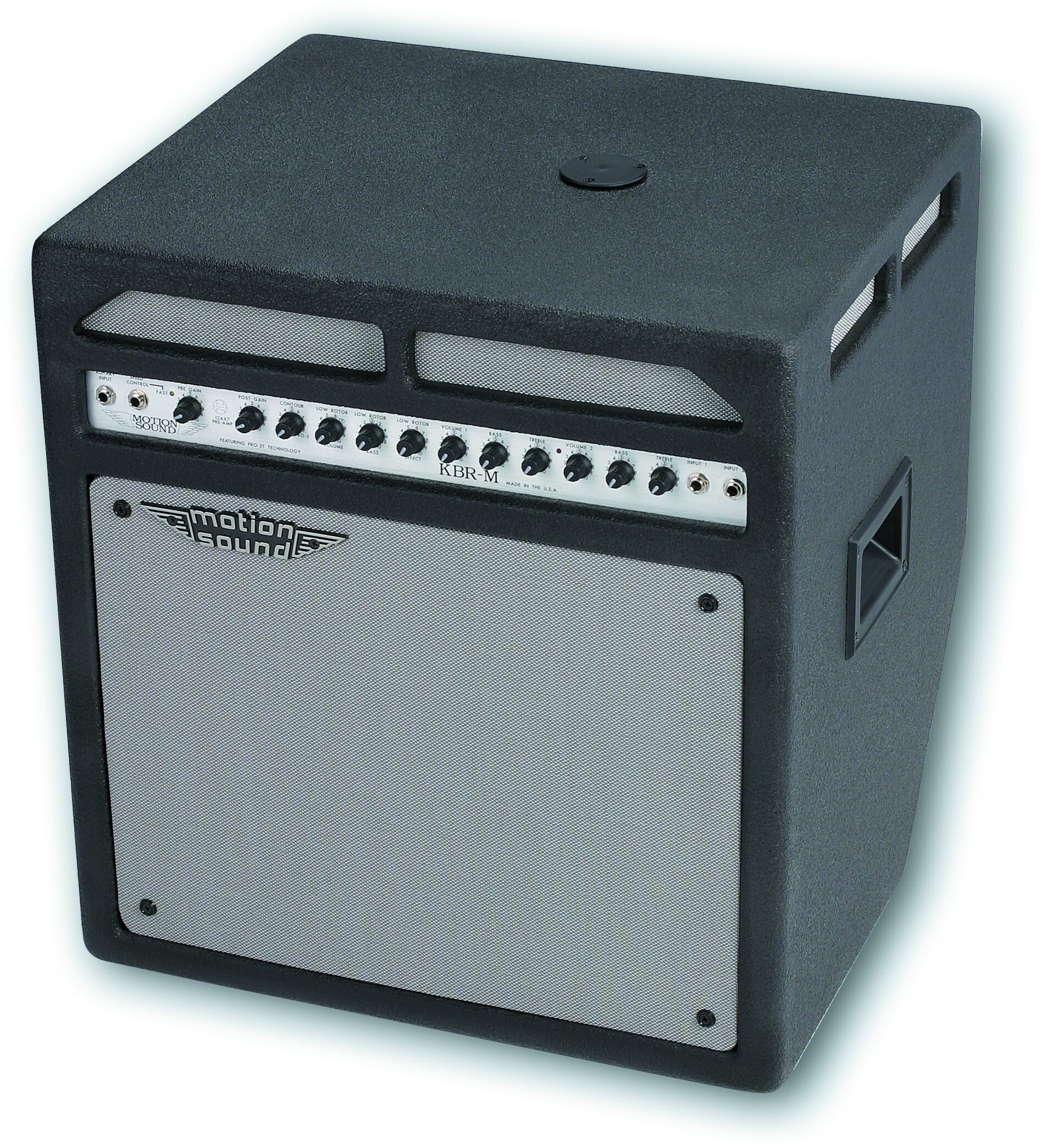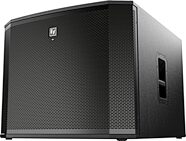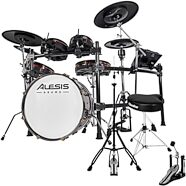Motion Sound KBRM Twin Mono Amp With PRO3T Speaker
No longer available at zZounds



zZounds Gear Experts Say...
Keyboard amp with 100 watts of power going into a 12 in. speaker and a 4 x 4 dynamic horn.
Overview
The sound of the organ is back in style. There are those who say it never left, but this is a grand time for the king of instruments. The synth guys have done a great job at making basic organ sounds, and there are a few incredible dedicated organ keyboards and modules. But reproducing the grinding sound of the rotating speaker has been a different kettle of fish entirely. All the digital multi-effects boxes boast rotary simulations, but they only hint at the real thing. Until recently, if you wanted the authentic vintage sound of rotating speakers, it meant dealing with dodgy electronics, fat cables, and big wooden boxes that weigh a ton. And you'll pay a premium price for that misery if you go the vintage route.
Motion Sound thought about this and found an answer. The vintage boxes had 2 elements, a "bass" rotor and a spinning horn, an internal crossover sent the proper frequencies to the proper elements, and voila, that unmistakable sound. Motion Sound learned that the bass rotor can be digitally simulated quite well, but nothing can take the place of the horn. So they built a box called the PRO3R, which was a spinning horn by itself and took the keyboard world by storm. It sounded like the real thing, was easy to hook up and carry, and was priced affordably. But you still had to have an amp to hear the digital bass rotor, not to mention the other keyboards that didn't have to go through the rotary system.
The KBRM is an integrated keyboard amp with 100 watts of power going… read more into a 12 in. speaker and a 4 x 4 dynamic horn. And mounted in the top of the surprisingly small and lightweight cabinet is a full blown PRO3R spinning horn! An innovative 3-channel mixer is also included onboard.
The first channel is the "Rotary channel." A real 12AX7 tube preamp makes the tone warm, and the pre and post gain controls let you add the right amount of tube crunch to the signal. A tonal contour dial lets you adjust the overall characteristics from mellow vintage to sharp modern sounds, and you can modify the low rotor simulator's level and effect depth. A provided footswitch with a blissfully long cord lets you choose between fast, slow, and stop. And YES it does speed up and slow down in the vintage way. Don't worry about miking up the rotor, because a mic is already built in, and the signal goes out the XLR jack in the back, combined with whatever else you have plugged in the front of the mixer.
The second channel is labeled "Channel One," and it can be used for a keyboard that doesn't need the rotor, or it can be used for a monitor signal from a PA board. A switch disengages this channel from the XLR connector on the back. The third or "Channel Two" input sends the signal through level, treble, and bass controls, and through the amp and speakers and XLR jack in the back.
The cabinet is fashioned in a way to lean back like a monitor, if so desired, or it can sit straight up.
Anybody who plays organ or organ samples needs this rig, guitarists who are looking for a new sound (although it's been used for years) can also use it. Electronic accordion players, this is for you, too! It's the best alternative to the big wooden box yet, and beats the pants off of the digital simulators. This product is USA designed and built, just like the vintage. read less
Motion Sound thought about this and found an answer. The vintage boxes had 2 elements, a "bass" rotor and a spinning horn, an internal crossover sent the proper frequencies to the proper elements, and voila, that unmistakable sound. Motion Sound learned that the bass rotor can be digitally simulated quite well, but nothing can take the place of the horn. So they built a box called the PRO3R, which was a spinning horn by itself and took the keyboard world by storm. It sounded like the real thing, was easy to hook up and carry, and was priced affordably. But you still had to have an amp to hear the digital bass rotor, not to mention the other keyboards that didn't have to go through the rotary system.
The KBRM is an integrated keyboard amp with 100 watts of power going… read more into a 12 in. speaker and a 4 x 4 dynamic horn. And mounted in the top of the surprisingly small and lightweight cabinet is a full blown PRO3R spinning horn! An innovative 3-channel mixer is also included onboard.
The first channel is the "Rotary channel." A real 12AX7 tube preamp makes the tone warm, and the pre and post gain controls let you add the right amount of tube crunch to the signal. A tonal contour dial lets you adjust the overall characteristics from mellow vintage to sharp modern sounds, and you can modify the low rotor simulator's level and effect depth. A provided footswitch with a blissfully long cord lets you choose between fast, slow, and stop. And YES it does speed up and slow down in the vintage way. Don't worry about miking up the rotor, because a mic is already built in, and the signal goes out the XLR jack in the back, combined with whatever else you have plugged in the front of the mixer.
The second channel is labeled "Channel One," and it can be used for a keyboard that doesn't need the rotor, or it can be used for a monitor signal from a PA board. A switch disengages this channel from the XLR connector on the back. The third or "Channel Two" input sends the signal through level, treble, and bass controls, and through the amp and speakers and XLR jack in the back.
The cabinet is fashioned in a way to lean back like a monitor, if so desired, or it can sit straight up.
Anybody who plays organ or organ samples needs this rig, guitarists who are looking for a new sound (although it's been used for years) can also use it. Electronic accordion players, this is for you, too! It's the best alternative to the big wooden box yet, and beats the pants off of the digital simulators. This product is USA designed and built, just like the vintage. read less
Specs
Rotary Channel: Features 12AX7 PRO-3T design with adjustable Low Rotor enhanced Simulator - PRE and Post Gain controls provide warm tube distortion at all volume settings. Contour, bass, and rotor balance provide EQ.
Channel One/Monitor: Features volume, bass, and treble controls and a switchable line feed allowing vocal monitor input from a PA mixing board to be heard without line signal output.
Channel Two: Features volume, bass, and treble controls and line output to rear panel XLR.
Dimensions (W x D x H): 19.5 x 21.5 x 17 in.; Monitor style stand up or layback rugged MDF cabinet
Weight: 58 lbs.
Power Output: 100 watts RMS .02% THD to Hi-Fi speaker system 40 watts RMS .02% THD > 800 hz to PD-40 Rotary Horn driver.
Channel One/Monitor: Features volume, bass, and treble controls and a switchable line feed allowing vocal monitor input from a PA mixing board to be heard without line signal output.
Channel Two: Features volume, bass, and treble controls and line output to rear panel XLR.
Dimensions (W x D x H): 19.5 x 21.5 x 17 in.; Monitor style stand up or layback rugged MDF cabinet
Weight: 58 lbs.
Power Output: 100 watts RMS .02% THD to Hi-Fi speaker system 40 watts RMS .02% THD > 800 hz to PD-40 Rotary Horn driver.
Reviews
Reviewers gave this product an overall rating of 4.5 out of 5 stars.
(35 ratings)
Submitted April 1, 2006 by a customer from yahoo.com
"Don't be fooled by the "rotary speaker emulation" on your korg or vk, GET ONE OF THESE."
Verified Customer
zZounds has verified that this reviewer made a purchase from us.
There's no substitute for the sound of the rotating speaker, and the only people I know of making these anymore is Motion Sound, so any replacement I'd buy would be another one. I'd probably spring for a larger unit.
Sound
The rotary horn sounds absolutely awesome. I don't think it sounds exactly like a Leslie (though it's probably closer to a 145 than a 122) but it definitely blows away ALL electronic attempts at rotary horn simulation by a huge margin. There's absolutely nothing like hearing that thing crank up and reflect the sound all around the room. I like the idea of the line out, but I think at low levels the "whoosh" of the rotating horn is too loud, so you have to crank the sucker. At the same time, the whole unit could use a little more dBs, it's a little small for big venues.
Features
No real features to speak of, other than the footswitch, which is fine. I'm a little disappointed in the tube preamp, it seems to take a *lot* of gain to get it to overdrive (but when it does, it sounds nice, but not as crunchy as I'd like)
Ease of Use
This is pretty easy to use. There aren't a lot of things that can go wrong on this front. I wish there was some display, though, that would let you know at a glance how fast the horn was spinning (there's a light for 'fast' but that's it) -- very useful on a dark stage.
Quality
Overall, seems OK. Changing… read more tubes is a pain, you need to remove the speakers to get at the access screws for the chassis for the amp which in turn slides out the back (the tube is at the front of the chassis so you're basically pulling sliding the whole PCB out to change the tube).
Value
I think the value is good for the money if you really want the rotary horn sound. You get a portable rotary speaker that's going to be more reliable and easier to service than the alternative (an old "real" Leslie)...before you buy some kind of simulator (or promise to depend on the built-in rotary speaker emulator of your keyboard) take the time to give one of these a listen!
Manufacturer Support
Support is good, I've emailed a couple times and gotten good response.
The Wow Factor
Don't buy this for looks (I consider this to be almost *too* functional looking, all business).
Musical Background:
professional player
Musical Style:
blues, jazz, progressive read less
Sound
The rotary horn sounds absolutely awesome. I don't think it sounds exactly like a Leslie (though it's probably closer to a 145 than a 122) but it definitely blows away ALL electronic attempts at rotary horn simulation by a huge margin. There's absolutely nothing like hearing that thing crank up and reflect the sound all around the room. I like the idea of the line out, but I think at low levels the "whoosh" of the rotating horn is too loud, so you have to crank the sucker. At the same time, the whole unit could use a little more dBs, it's a little small for big venues.
Features
No real features to speak of, other than the footswitch, which is fine. I'm a little disappointed in the tube preamp, it seems to take a *lot* of gain to get it to overdrive (but when it does, it sounds nice, but not as crunchy as I'd like)
Ease of Use
This is pretty easy to use. There aren't a lot of things that can go wrong on this front. I wish there was some display, though, that would let you know at a glance how fast the horn was spinning (there's a light for 'fast' but that's it) -- very useful on a dark stage.
Quality
Overall, seems OK. Changing… read more tubes is a pain, you need to remove the speakers to get at the access screws for the chassis for the amp which in turn slides out the back (the tube is at the front of the chassis so you're basically pulling sliding the whole PCB out to change the tube).
Value
I think the value is good for the money if you really want the rotary horn sound. You get a portable rotary speaker that's going to be more reliable and easier to service than the alternative (an old "real" Leslie)...before you buy some kind of simulator (or promise to depend on the built-in rotary speaker emulator of your keyboard) take the time to give one of these a listen!
Manufacturer Support
Support is good, I've emailed a couple times and gotten good response.
The Wow Factor
Don't buy this for looks (I consider this to be almost *too* functional looking, all business).
Musical Background:
professional player
Musical Style:
blues, jazz, progressive read less
9 of 9 people (100%) people found this review helpful. Did you?
Thanks for your opinion!
No longer available at zZounds
In most cases, a product is unavailable because it has been discontinued by the manufacturer
This is a carousel with product cards. Use the previous and next buttons to navigate.










